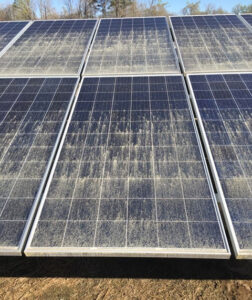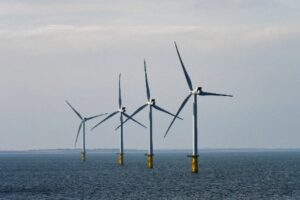Blame it on the rain! NREL says precipitation can’t completely clean pollen from solar panels


Researchers determined that rainfall is not enough to adequately clean solar panels covered in pollen (Credit: NREL).
New research led by the U.S. Department of Energy’s National Renewable Energy Laboratory (NREL) found that while rainfall can wash away some pollen from solar panels, it can’t rinse enough to return the panels’ photovoltaic (PV) performance to their original levels – with performance decreases up to 15% encountered.
The researchers examined the effects of pollen on the performance of five utility-scale solar plants in North Carolina. Their ensuing publication, “An Investigation on the Pollen-Induced Soiling Losses in Utility-Scale PV Plants,” appears in the IEEE Journal of Photovoltaics. The team said their findings ran counter to a common assumption that frequent rainfall would result in negligible soiling impacts.
Performance decreased by as much as 15% during peak pollen season, the researchers said, when most pollens come from cypress, juniper, pine, and oak trees. Although these are peak losses, researchers said the data suggests total production losses could be up to 10% without regular cleaning.
Once peak pollen season ended, the panels’ performance did not return to their “cleaned” levels, even after frequent rains.
GO DEEPER: Lucy Bullock-Sieger, vice president of strategy for developer Lightstar Renewables, joined Episode 46 of the Factor This! podcast to discuss a new approach to agrivoltaics. Subscribe wherever you get your podcasts.
NREL asserts the findings confirm that soiling potential must be carefully examined in regions with frequent rainfall and that planned cleaning may be necessary to avoid large financial losses and system underperformance. As a result of this work, NREL and Solar Unsoiled are designing a study to further investigate the mechanisms and risks associated with pollen and bio-soiling in the southeastern United States.
The solar plants had all been operational for more than seven years at the time of the analysis, without any manual cleaning performed, the team said. Solar Unsoiled, working in conjunction with the system owner, measured performance increases from 5% to 11% following mechanical wet brush cleaning.
“There is still much work to do to fully understand the risks and implications of pollen and bio-soiling in the southeast U.S., but this work has made clear that regular rainfall is not sufficient to assume that solar plants are fully cleaned in certain environments,” said Matthew Muller, a research engineer within the PV Performance and Reliability group at NREL and co-author of a new paper describing the problem with pollen.
Soiling, which occurs when dust, pollen, or other elements hinder light from reaching solar cells, has emerged as an ongoing problem both in terms of PV performance and realized revenue for solar plant operators, NREL said. The level of severity soiling presents depends on local conditions and climate. Previous research has estimated soiling losses in arid and semi-arid locations but not in rainier locations where pollen is a problem, such as in the southeastern United States.
Authors of the paper include Matthew Muller, a research engineer within the PV Performance and Reliability group at NREL, Joao Gabriel Bessa, who visited NREL from the University of Jaen in Spain; Michael Valerino, who co-founded Solar Unsoiled; and researchers from the University of Jaen, Duke University, and Sapienza University of Rome.
The full paper can be read here.




